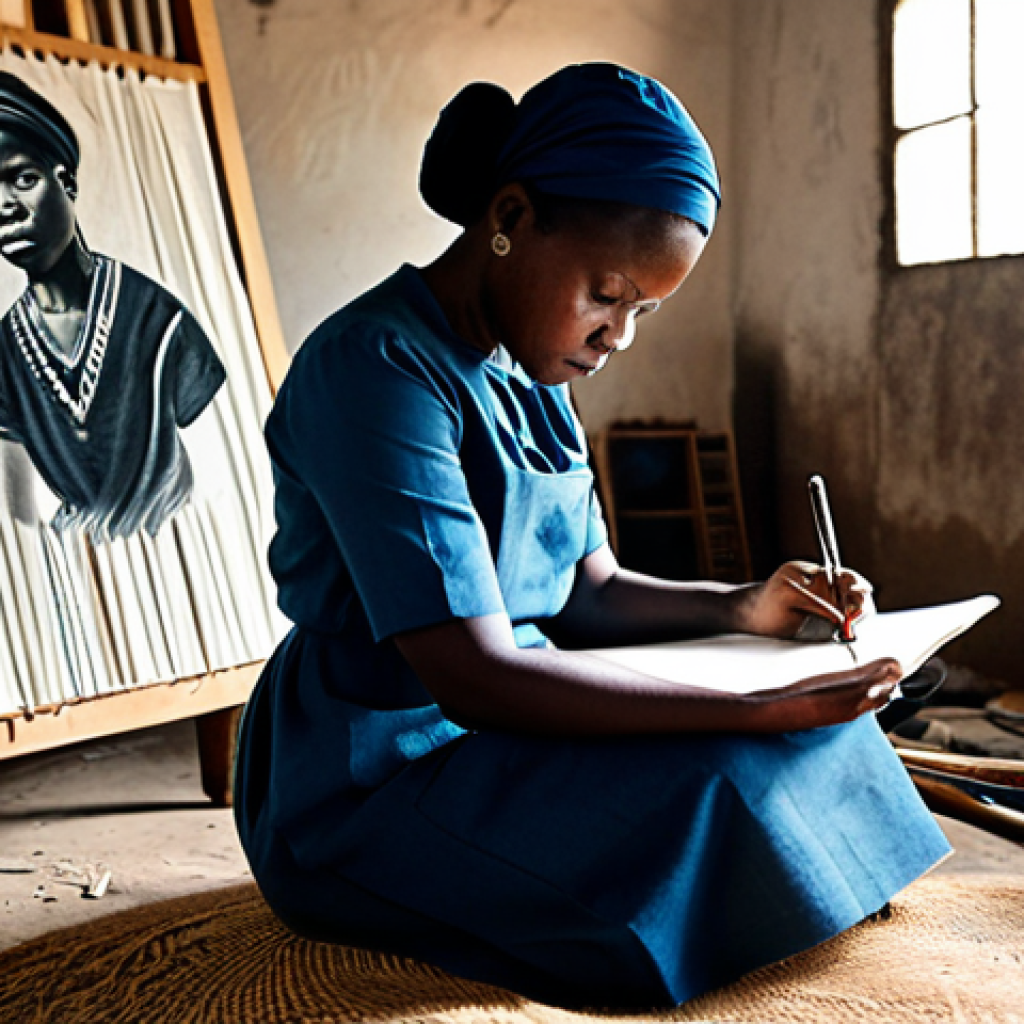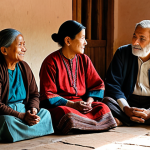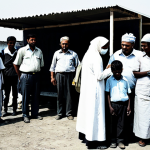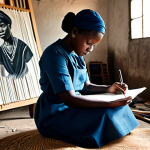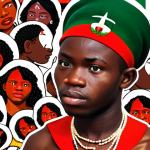The Biafran War, a brutal conflict from 1967 to 1970, is often reduced to its devastating statistics and political complexities. Yet, when I really dive into the narratives, what truly strikes me is the profound cultural upheaval it instigated, fundamentally reshaping identities and expressions in ways that still resonate profoundly today.
It wasn’t merely a battle for land or sovereignty; it was a crucible that forged powerful new art forms, music, and literary movements, born from unimaginable hardship and resilience.
You can’t help but see how such intense periods can forever alter a society’s soul, leaving an indelible mark on its artistic landscape and collective memory.
It’s fascinating, yet heartbreaking, to consider how conflict, especially one as devastating as this, doesn’t just destroy but also, paradoxically, sparks incredible creative and cultural transformations.
I’ve often found myself pondering how societies rebuild, not just infrastructure, but their very spirit, through art, music, and storytelling. This era, in particular, saw a powerful surge of literary voices and artistic expressions that redefined what it meant to be Igbo, Nigerian, and even human in the face of immense suffering.
From the poignant poetry to the vibrant visual arts, these cultural shifts weren’t just reactions; they were profound statements of survival and identity.
In today’s interconnected world, where we often grapple with issues of cultural preservation and the impact of global conflicts, understanding the Biafran experience offers invaluable lessons.
It forces us to confront how historical trauma can reshape the fabric of a nation’s artistic soul, and why those echoes remain so relevant in our ongoing conversations about identity and resilience, especially as we navigate increasingly complex global dynamics.
Let’s delve deeper into this.
The Unyielding Spirit: Art as a Silent Weapon of Resistance
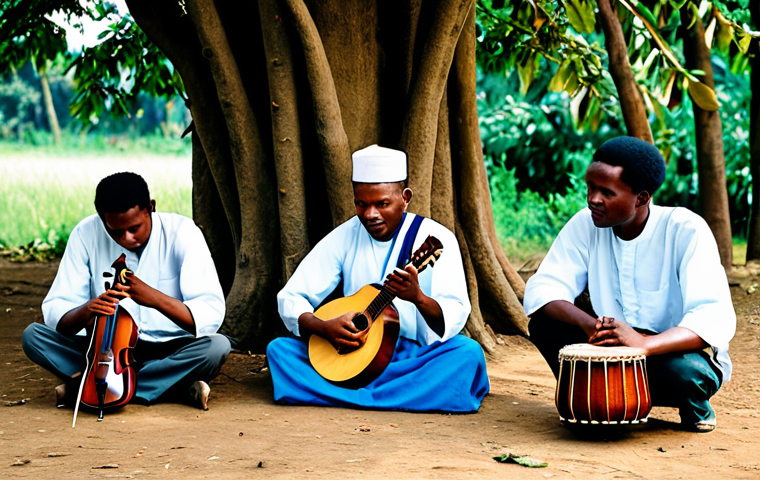
When I reflect on conflicts like the Biafran War, I’m always profoundly moved by how art, in its myriad forms, often emerges not just as a reflection of suffering but as a potent, defiant act of survival.
It’s truly incredible how, even in the direst circumstances, the human spirit finds a way to express itself, to make a statement, to resist complete annihilation of identity.
During the Biafran War, visual arts became far more than mere decoration; they transformed into vital conduits for hope, protest, and the preservation of a unique cultural heritage.
I can only imagine the desperate urgency artists must have felt, knowing that every brushstroke, every sculpture, could be a final testament to their existence and beliefs.
It wasn’t just about creating beauty; it was about creating meaning, forging solidarity, and projecting an identity that the war sought to erase. This period truly redefined what art could be in the face of overwhelming adversity, turning simple mediums into powerful narratives that transcended the immediate horrors of the battlefield.
It always reminds me that true resilience isn’t just about enduring, but about creating and asserting one’s very being.
1. Visual Narratives of Resilience and Loss
Walking through certain exhibitions or looking at archives, I’m always struck by the raw honesty in the visual art from the Biafran War era. Artists like Uche Okeke, Demas Nwoko, and Bruce Onobrakpeya, even those who might not have been directly on the front lines, channeled the collective trauma and unwavering resolve of their people into powerful visual narratives.
These weren’t just pretty pictures; they were windows into a soul-shattering experience. I recall seeing an exhibition once, and one particular piece, a stark, almost skeletal drawing, depicted a mother holding a starving child.
The emotional weight of it was palpable, almost suffocating. It wasn’t just an image; it was a scream, a prayer, a testament to unimaginable loss, yet it also carried an underlying current of defiance, a refusal to be broken.
These artworks, often utilizing readily available materials like charcoal, paint on repurposed fabrics, or crude sculptures from salvaged wood, became historical documents, capturing the nuances of everyday life under siege, the hunger, the fear, but also the enduring spirit, the community bonds, and the defiant hope that somehow, things would get better.
They created a visual vocabulary for a war that was often misrepresented or ignored globally, allowing those who experienced it to articulate their truth and for future generations to bear witness.
2. Crafting Identity Through Artistry
What fascinates me most about the art from this period is its profound connection to identity. When a people are fighting for their very existence, their cultural markers become incredibly important, almost sacred.
For the Igbo people, their unique artistic traditions, from intricate masquerades to distinct pottery and textile designs, became symbols of their fight for self-determination.
Artists didn’t just document the war; they actively participated in the cultural reassertion. They drew upon traditional motifs, reinterpreting them to speak to the contemporary crisis.
It’s a powerful statement when, amidst the chaos, you choose to invest your energy in creating something that affirms who you are. I often think about how essential it is, when everything else is being stripped away, to cling to the things that make you, *you*.
The act of creating and displaying these works, even in clandestine ways, was an assertion of sovereignty, a declaration that their culture would not be erased, regardless of the political outcome.
This deep intertwining of art and identity became a defining characteristic of Biafran cultural expression, proving that even under siege, culture not only survives but often flourishes in new, powerful ways.
Echoes of Survival: Literature and the Quest for Narrative Control
There’s a particular kind of raw power that emerges in literature born from conflict, a searing honesty that you rarely find elsewhere. The Biafran War, while devastating in its human cost, paradoxically became a fertile ground for an explosion of literary voices, shaping what we now understand as post-colonial African literature in profound ways.
For me, personally, delving into these works feels less like reading history and more like experiencing it, hearing the whispered anxieties and shouted defiance directly from those who lived through it.
It’s where the statistics give way to individual lives, to the gnawing hunger, the constant fear of bombs, and the inexplicable moments of joy or solidarity that somehow break through the darkness.
Writers during and after this period weren’t just chronicling events; they were actively engaged in a battle for narrative control, determined to ensure that their story, their suffering, and their resilience would be told truthfully, unvarnished by external interpretations or political agendas.
This era showed how deeply embedded storytelling is in our survival, how essential it is to process trauma, to grieve, and ultimately, to rebuild.
1. Literary Giants and Their Wartime Testimonies
When you talk about Biafran War literature, Chinua Achebe’s *There Was a Country* immediately comes to mind, a deeply personal and moving account that really allows you to grasp the human side of the conflict.
But beyond Achebe, a whole constellation of brilliant minds emerged, determined to bear witness. Christopher Okigbo, one of Nigeria’s most celebrated poets, tragically died in the war, but his works, imbued with classical allusions and Igbo oral traditions, spoke volumes about identity and the futility of conflict.
Wole Soyinka, though imprisoned during the war for his efforts towards a peaceful resolution, also brought a powerful, critical voice to the table, challenging the political landscape through his plays and prose.
Even though he wasn’t directly part of the Biafran side, his experience resonates deeply with the human cost of the conflict. I remember reading Flora Nwapa’s *Never Again*, one of the earliest novels by a Nigerian woman writer to focus directly on the war.
Her portrayal of the daily struggles of women and children, often overlooked in grand historical narratives, felt incredibly authentic and heartbreaking.
These authors weren’t just writing stories; they were crafting monuments of memory, ensuring that the sheer scale of the human experience, from the heroic to the horrifying, would never be forgotten.
They used their words as a shield, a weapon, and a balm for a shattered nation.
2. The Novel as a Vehicle for Collective Memory
What’s truly striking about the novels that emerged from or were inspired by the Biafran War is their collective power to shape and preserve memory. They don’t just present facts; they immerse you in the emotional landscape of the time.
The themes of survival, betrayal, identity crisis, the rupture of community, and the search for meaning in the face of senseless violence are woven throughout these narratives.
Think about Elechi Amadi’s *Sunset in Biafra*, which offers a poignant glimpse into the psychological toll of the war on ordinary people, or Chimamanda Ngozi Adichie’s *Half of a Yellow Sun*, which, though written much later, meticulously recreates the era with an incredible depth of human emotion, bringing the conflict to a new generation of readers.
What I’ve found so impactful is how these authors manage to convey not just the grand sweep of history but also the granular, lived experience: the taste of hunger, the smell of fear, the sound of distant shelling, the complex moral dilemmas faced every single day.
They serve as vital counter-narratives to purely political or military histories, offering a humanizing perspective that is absolutely essential for true understanding.
It’s like stepping into someone else’s shoes and feeling their pain, their hope, and their enduring spirit.
Rhythms of Defiance: How Music Carried the Soul of a Nation
Music, for me, has always been the most visceral and immediate expression of human emotion. When words fail, or when public speech is too dangerous, music often steps in, carrying messages, stories, and the very spirit of a people.
During the Biafran War, this was amplified a thousandfold. The rhythms and melodies born from that crucible of conflict weren’t just entertainment; they were lifelines, protest anthems, eulogies, and calls for unity.
I can only imagine the solace and strength that a shared song must have offered in the midst of air raids or deep despair. It wasn’t just about the lyrics; it was about the collective act of singing, of dancing, of finding a moment of shared humanity and defiance against an overwhelming darkness.
Music truly became the heartbeat of a nation under siege, reflecting both its agony and its indomitable will to survive. It’s a profound testament to the power of art to transcend mere aesthetics and become an essential tool for social cohesion and psychological survival.
1. War Songs as Unifying Ballads
In times of war, music often takes on new, profound meanings. During the Biafran conflict, songs served multiple purposes: they boosted morale, disseminated information (often coded), and articulated the shared experiences of suffering and resilience.
Musicians, some well-known and others who became local heroes, composed and performed songs that resonated deeply with the Biafran people. These were not polished studio recordings; many were simple, heartfelt compositions passed along orally or played on makeshift instruments.
They spoke of the sacrifices being made, the longing for peace, and the unwavering belief in their cause. I’ve heard accounts of how these songs were sung in refugee camps, in trenches, and in homes, providing a crucial sense of community and a collective voice to express sorrow, anger, and hope.
It’s a powerful reminder that culture isn’t just something you consume; it’s something you actively participate in, something that binds you together when everything else is tearing apart.
These war songs, in their raw authenticity, became the folk history of a struggling nation, preserving narratives and emotions that might otherwise have been lost to the fog of conflict.
2. Highlife and Igbo Identity
Highlife music, with its infectious rhythms and poignant lyrics, was already a popular genre in Nigeria before the war, but it took on a particularly vital role in Biafra.
Many prominent Highlife musicians were Igbo, and their music became intrinsically linked with the Biafran cause. Artists like Celestine Ukwu, whose mournful yet hopeful melodies encapsulated the spirit of the times, saw their music become anthems of the struggle.
I’ve always found it fascinating how cultural forms, already beloved, can be co-opted and infused with new political meaning during periods of intense social upheaval.
The rhythms themselves seemed to carry the heartbeat of Igbo identity, and the lyrics, often sung in Igbo, reinforced cultural pride and a sense of shared destiny.
Listening to some of these old tracks, you can still feel the palpable emotion, the blend of melancholic reflection and resolute determination. It wasn’t just music; it was a cultural lifeline, a means for people to connect with their heritage and reaffirm their identity in the face of existential threat.
This period truly solidified Highlife’s place not just as a genre, but as a crucial component of Igbo cultural resilience.
Forging Identity in the Crucible: Redefining Self Amidst Chaos
One of the most profound, yet often overlooked, aspects of any major conflict is its capacity to fundamentally reshape identity. When the very foundations of your world are shaken, when familiar structures collapse, you’re forced to look inward and collectively re-evaluate who you are.
The Biafran War was precisely such a crucible, forging new dimensions of what it meant to be Igbo, and indeed, what it meant to be Nigerian, amidst the trauma of secession and civil strife.
It wasn’t just about political boundaries; it was about the internal landscape of selfhood. I’ve often thought about how devastating it must be to have your identity, your sense of belonging, suddenly called into question, to be forced to choose or create a new narrative for yourself and your community.
This period saw an intense process of self-definition, where culture, language, and shared experience became anchors in a storm of uncertainty. It’s a powerful reminder that identity isn’t static; it’s a dynamic, evolving construct, often shaped most intensely by the fires of adversity.
1. The Igbo Experience and Emergent Identity
Before the war, the term “Igbo” represented a diverse ethnic group within the larger Nigerian federation. The war, however, created a singular, powerful, and often traumatic collective experience that solidified a distinct Biafran-Igbo identity.
Suddenly, being Igbo wasn’t just about shared language or customs; it was about shared suffering, shared aspirations for self-determination, and shared defiance against what was perceived as an existential threat.
I’ve read countless personal accounts that describe this shift – how individuals who might have identified more strongly with their immediate town or village prior to the conflict found a profound sense of solidarity with all who shared the Biafran struggle.
This wasn’t merely a political label; it became a deeply personal and emotional affiliation. It manifested in cultural expressions, from the rallying cries in songs to the poignant themes in literature, all reinforcing this emergent, unified identity forged in the fires of conflict.
It truly highlights how extreme circumstances can compress centuries of identity formation into just a few short, brutal years.
2. The Broader Nigerian Identity in Question
While the Biafran experience solidified a distinct Igbo identity, the war also cast a long shadow over the broader concept of Nigerian identity. The conflict laid bare deep-seated ethnic tensions and unresolved questions about national unity.
For many, the idea of a cohesive Nigerian nation, born from the amalgamation of diverse peoples under British colonial rule, was profoundly challenged.
I imagine it must have been incredibly disorienting for those who had grown up believing in a unified Nigeria to suddenly find themselves on opposing sides of a brutal civil war.
The question of “who are we?” became central, not just for Biafrans, but for all Nigerians. Post-war literature, art, and music often grapple with this fractured identity, exploring themes of reconciliation, forgiveness, and the painful process of rebuilding a sense of nationhood.
It serves as a stark reminder that national identity is a delicate construct, constantly needing nurturing and understanding, especially in societies with diverse ethnic and religious groups.
The Biafran War, in many ways, forced Nigerians to confront the complexities of their shared future, leaving an indelible mark on the collective consciousness and the ongoing discourse about what it truly means to be Nigerian.
| Cultural Domain | Key Artists/Works/Movements | Impact on Biafran Identity/Narrative |
|---|---|---|
| Visual Arts | Uche Okeke, Demas Nwoko, Bruce Onobrakpeya, Oresegun Olumide (post-war, inspired) | Expressed suffering and resilience; preserved unique cultural motifs; served as visual testimony and protest. |
| Literature & Poetry | Chinua Achebe, Christopher Okigbo, Flora Nwapa, Elechi Amadi, Chimamanda Ngozi Adichie | Created powerful narratives of human experience; preserved historical memory; challenged external interpretations of the war; explored themes of loss, survival, and fractured identity. |
| Music | Celestine Ukwu, Osita Osadebe (Highlife genre) | Boosted morale; disseminated information; became anthems of defiance; reinforced Igbo cultural pride and unity; reflected emotional landscape of the war. |
| Performance Arts (Masks, Drama) | Traditional masquerades adapted for wartime messaging; community theatre | Maintained cultural traditions; provided communal expression and psychological release; adapted to convey wartime messages and satire. |
The Legacy Etched in Creativity: Preserving Biafra’s Cultural Footprint
Even decades after the last shot was fired, the cultural footprint of the Biafran War remains incredibly vivid and potent. It’s not just a historical footnote; it’s a living, breathing testament to how deeply conflict can scar, yet simultaneously inspire.
What often strikes me is how the very act of survival translated into a fierce determination to preserve and proliferate the cultural expressions born from that era.
This isn’t just about remembering a past conflict; it’s about understanding how a profound national trauma can embed itself within the artistic DNA of a people, shaping subsequent generations of creators and thinkers.
I’ve seen how artists today, who weren’t even alive during the war, draw upon its imagery, its stories, and its emotional weight to comment on contemporary issues of injustice, identity, and resilience.
It’s a testament to the enduring power of art as a vessel for collective memory, ensuring that the lessons and experiences of Biafra continue to resonate, not just in Nigeria, but across the globe.
This legacy isn’t confined to dusty archives; it’s vibrant, evolving, and critically important for understanding the ongoing human journey.
1. Archiving and Remembering Through Art
One of the most crucial aspects of the Biafran War’s cultural legacy is the ongoing effort to archive and remember its impact through art and literature.
Institutions, both within Nigeria and internationally, have been pivotal in collecting, preserving, and exhibiting works from or inspired by this period.
From the meticulous preservation of personal letters and photographs to the curation of art collections and the publication of oral histories, these efforts ensure that the voices from that time are not silenced.
I’ve often felt a deep sense of responsibility, as someone interested in history, to seek out these primary sources, these artistic interpretations, because they offer a nuance and emotional depth that pure historical texts often cannot.
It’s an active process of cultural preservation, recognizing that these artistic outputs are not just aesthetic objects but vital historical documents, imbued with the pain, resilience, and unique perspective of a people who endured unimaginable hardship.
This deliberate act of remembering through art is fundamental to ensuring that future generations can learn from the past and that the sacrifices made are never forgotten.
2. Contemporary Artistic Reflections
Perhaps the most compelling aspect of Biafra’s cultural legacy is its continued resonance in contemporary art and literature. Young Nigerian artists, writers, and musicians, many born long after the war ended, are still engaging with its themes, reinterpreting its narratives, and exploring its lingering psychological and social effects.
Think of the powerful poetry that still addresses the emotional scars, the visual art that uses abstract forms to depict the trauma, or the contemporary music that samples old Biafran anthems to comment on current political realities.
I find this incredibly powerful because it shows that history isn’t just something that happened; it’s something that continues to shape the present. These contemporary reflections are not mere repetitions; they are dynamic explorations, often bringing new perspectives, challenging old narratives, and forcing fresh dialogues about identity, reconciliation, and nation-building.
It’s a clear indication that the cultural impact of the Biafran War is far from over; it continues to inspire, provoke, and inform the ongoing conversation about Nigeria’s past, present, and future, proving that true artistry often finds its deepest roots in collective memory.
Beyond the Battlefield: The Global Resonance of Biafran Artistic Expression
It’s easy to view historical conflicts through a narrow, localized lens, but the truth is, profound human experiences, especially those expressed through art, often transcend geographical and political boundaries.
The cultural output of the Biafran War, born from a desperate struggle, found an audience and resonance far beyond the borders of Nigeria. This global impact, for me, underscores the universal language of suffering, resilience, and the human spirit’s unwavering will to express itself.
It wasn’t just about garnering sympathy for a cause; it was about sharing a piece of the human condition that spoke to people across diverse cultures and experiences.
I’ve personally encountered individuals from entirely different backgrounds who were deeply moved by Biafran literature or art, finding echoes of their own struggles or a profound sense of shared humanity in the stories and images.
This outward reach of Biafra’s cultural expressions highlights the power of art to bridge divides, foster empathy, and ensure that lessons learned in one corner of the world can offer insights and warnings to others.
1. International Solidarity and Artistic Exchange
During the war, and in its immediate aftermath, Biafran artists and writers, often displaced or exiled, played a crucial role in shaping international perceptions and garnering solidarity.
Their works became powerful tools of advocacy, communicating the humanitarian crisis and the political complexities to a global audience. Publications like *Transition* magazine and institutions in Europe and North America provided platforms for these voices, allowing them to circumvent censorship and reach a wider readership.
I recall reading about how some artists would smuggle their work out of Biafra, risking their lives to ensure the world saw their truth. This wasn’t just about showcasing talent; it was a desperate plea for understanding and intervention.
This period fostered an intense, albeit often difficult, artistic and intellectual exchange, where the raw experiences of the war challenged existing notions of post-colonialism, human rights, and global responsibility.
It became a powerful example of how art can serve as a form of diplomacy, creating connections and fostering understanding where traditional political channels might fail.
2. Universal Themes of Conflict and Resilience
While specific to Biafra, the cultural expressions born from the war resonate globally because they tap into universal human themes. The struggle for identity, the experience of displacement, the resilience of the human spirit in the face of unimaginable hardship, the trauma of conflict, and the enduring power of hope – these are experiences that transcend specific geographies or historical moments.
When you read a novel like *Half of a Yellow Sun* or see a poignant piece of art from that era, you don’t just see the Biafran War; you see a reflection of the human cost of all conflicts.
I’ve often thought about how art from such periods serves as a stark reminder of the universal impact of violence and the shared human capacity for both immense cruelty and extraordinary compassion.
This universal appeal ensures that the cultural legacy of the Biafran War remains relevant, not just for Nigerians, but for anyone grappling with issues of conflict, humanitarian crises, and the ongoing quest for peace and understanding in an increasingly interconnected world.
It tells a specific story that speaks to the shared human experience.
Personal Echoes: What the Biafran Cultural Resurgence Teaches Us Today
As someone who spends a lot of time thinking about how history shapes us, the cultural resurgence born from the Biafran War consistently leaves me with a profound sense of awe and a host of crucial lessons.
It’s not just a historical curiosity; it’s a living example of how even the most catastrophic events can, paradoxically, become catalysts for extraordinary human creativity and resilience.
When I delve into the literature, the art, the music, I don’t just see a war; I see the human spirit in its rawest, most defiant form, refusing to be silenced or extinguished.
What really strikes me is how these expressions, born from such deep pain, ultimately become powerful tools for healing, reconciliation, and shaping a collective future.
It’s a testament to the idea that culture isn’t a luxury; it’s an absolute necessity for survival, for processing trauma, and for forging new pathways forward.
This ongoing exploration of the Biafran cultural legacy reminds me, time and again, of the incredible power humans possess to find beauty, meaning, and a path toward resilience even amidst the darkest of times.
1. Art as a Pathway to Healing and Reconciliation
One of the most poignant lessons I’ve taken from studying the cultural output of the Biafran War is the vital role art plays in post-conflict healing and reconciliation.
When a society has been fractured by violence, words alone, especially political ones, often fall short. Art, however, whether it’s a mournful song, a powerful play, or a vivid painting, can access deeper emotional truths.
It creates spaces for shared grief, for acknowledgment of suffering, and for dialogues that might otherwise be too painful or divisive. I’ve heard stories of former combatants or affected communities finding common ground through cultural expressions, realizing that their shared humanity, their shared trauma, is more significant than their past divisions.
This isn’t a quick fix, of course, but a gradual, often arduous process. Yet, the cultural expressions from Biafra demonstrate how artistic narratives can help societies to process collective trauma, to reflect on their past without being consumed by it, and to slowly, painstakingly, build bridges towards a more unified future.
It reminds me that true peace isn’t just the absence of war, but the presence of understanding and empathy, often fostered through shared artistic experiences.
2. The Enduring Power of Cultural Preservation
Finally, the Biafran experience profoundly emphasizes the critical importance of cultural preservation, not just for historical record, but for ongoing societal well-being.
In a world increasingly homogenized by global influences, the distinct cultural expressions that emerged from Biafra serve as a powerful reminder of the unique strength and identity inherent in diverse cultures.
It highlights how, when a people are threatened, their culture becomes a bastion of resistance and a source of collective strength. I find myself constantly reflecting on how much we can learn from this example about protecting and nurturing our unique cultural heritages, not just for their aesthetic value, but for their intrinsic role in defining who we are, where we come from, and where we are going.
The enduring legacy of Biafran art, literature, and music isn’t just about a past conflict; it’s about the ongoing vitality of human culture as a force for survival, identity, and enduring hope against all odds.
It truly reinforces my belief that to lose a culture is to lose a part of humanity itself, and that the fight to preserve it, especially through art, is a fight worth waging every single day.
Final Thoughts
As I look back on this journey through the cultural landscape of the Biafran War, what truly resonates with me is the indomitable spirit of humanity. It’s a powerful testament to how, even when faced with utter devastation, creativity doesn’t just survive; it thrives, becoming a lifeline for a people under siege. The art, literature, and music born from that period aren’t just historical artifacts; they are vibrant echoes of resilience, demonstrating that true strength isn’t merely enduring, but creating, expressing, and ultimately, healing. This ongoing legacy reminds me that culture is never just a backdrop to history; it is often the very force that shapes it, offering solace, purpose, and a path forward through the darkest of times.
Useful Information
1. Explore Online Archives: Many universities and historical societies (e.g., SOAS University of London, various Nigerian institutions) house digitized collections of Biafran War materials, including art, literature excerpts, and oral histories. A simple search can reveal incredible resources for deeper study.
2. Read Key Texts: If you’re looking to delve deeper, start with Chinua Achebe’s memoir “There Was a Country” for a foundational personal perspective. For fiction, Chimamanda Ngozi Adichie’s “Half of a Yellow Sun” offers a rich, humanizing portrayal of the era.
3. Visit Relevant Exhibitions: Keep an eye out for exhibitions at major museums or galleries specializing in African art or post-colonial history. These often feature visual art from the period and provide invaluable context that online resources cannot fully capture.
4. Engage with Literary Festivals: Many literary festivals, particularly those focusing on African literature, often host panels or discussions with authors who have written about the Biafran War or its legacy. This offers a chance to hear directly from contemporary voices.
5. Support Cultural Preservation Initiatives: Consider supporting organizations dedicated to preserving African history and culture. These efforts are crucial for ensuring that the rich artistic heritage of periods like the Biafran War continues to be accessible for future generations.
Key Takeaways
The Biafran War, while a period of immense suffering, catalyzed an extraordinary cultural outpouring across visual arts, literature, and music. These artistic expressions served as powerful forms of resistance, preserving identity, bearing witness to trauma, and fostering collective memory. Art became a vital tool for survival, processing grief, and asserting sovereignty. Decades later, its legacy continues to resonate globally, inspiring contemporary artists and serving as a crucial pathway for healing, reconciliation, and cultural preservation, highlighting art’s enduring power to connect, inform, and inspire in the face of adversity.
Frequently Asked Questions (FAQ) 📖
Q: It feels almost paradoxical that such immense suffering during the Biafran War could actually ignite new art forms and cultural movements. How do you explain this seemingly contradictory surge of creativity amidst utter devastation?
A: You know, it’s something I’ve wrestled with a lot when I dig into these histories – how tragedy, real, gut-wrenching trauma, doesn’t always just crush the human spirit; sometimes, it refines it, sharpens it into something unbelievably resilient.
When I think about the Biafran War, I don’t see mere destruction, but a brutal crucible. People were stripped bare, their old realities shattered. What happens then?
You have to find new ways to articulate your existence, your pain, your hope, your very identity, because the old words just don’t fit anymore. It’s like a profound, collective need to scream, to weep, to rebuild, but instead of with bricks, it’s with brushstrokes, melodies, and searing prose.
It wasn’t a choice; it was survival. Art became the language of a people fighting to simply be, even when everything was trying to erase them. It’s almost as if the sheer pressure forced an eruption of creativity that had been lying dormant.
Q: So, if this intense period sparked such powerful cultural transformations, what specific forms did these new artistic expressions take?
A: nd how did they actually redefine identity for the Igbo, and by extension, for Nigerians, in the face of such immense loss? A2: Oh, the forms were incredibly diverse, and each one a testament to that raw resilience!
I’ve always been particularly struck by the literature. Think about the poets and novelists who emerged, like Chinua Achebe, though his major works predated the war, his later reflections and the works of others like Flora Nwapa and Cyprian Ekwensi were profoundly shaped by it.
There was this surge of literary voices, often expressing the deep anguish, the betrayal, but also the enduring spirit and the struggle for self-definition.
Beyond literature, you saw vibrant visual arts; artists were using traditional motifs but imbued with new, stark meanings of conflict and survival. And the music!
Music became a powerful tool for protest, for lament, for preserving memory, and for maintaining communal bonds. It wasn’t just entertainment; it was a heartbeat.
These expressions weren’t just about documenting the war; they actively redefined what it meant to be Igbo—no longer just a tribe within Nigeria, but a people who had endured a specific, horrific trial, a people with a unique story of survival and resistance.
For Nigerians as a whole, it forced a painful reckoning with national identity, challenging them to integrate this traumatic chapter into their collective narrative.
It truly reshaped the very soul of the nation’s artistic landscape.
Q: Given how much the Biafran War reshaped artistic and cultural identity, why is understanding this specific historical experience so important for us today, especially when we consider ongoing global conflicts and cultural preservation?
A: That’s a truly critical question, and one I find myself pondering often. I mean, we live in a world that feels increasingly interconnected yet fragmented, right?
We’re constantly grappling with cultural clashes, the impact of displacement, and the heartbreaking toll of conflict. The Biafran experience offers this incredibly poignant, almost visceral case study.
It forces us to confront how historical trauma isn’t just about numbers or maps; it profoundly, indelibly marks a society’s artistic soul. When you see how people, under unimaginable duress, found their voice through art and storytelling, it underscores the absolute necessity of cultural preservation – not just as an academic exercise, but as a vital part of healing and continuity.
It shows us that culture isn’t a static thing to be preserved in a museum; it’s a living, breathing response to our collective experiences. Understanding Biafra helps us see that these cultural echoes from past conflicts remain incredibly relevant in our present-day conversations about identity, resilience, and the sheer human capacity to endure and rebuild, even after the worst has happened.
It’s a testament to the fact that art isn’t a luxury; it’s fundamental to survival.
📚 References
Wikipedia Encyclopedia
구글 검색 결과
구글 검색 결과
구글 검색 결과
구글 검색 결과
구글 검색 결과
